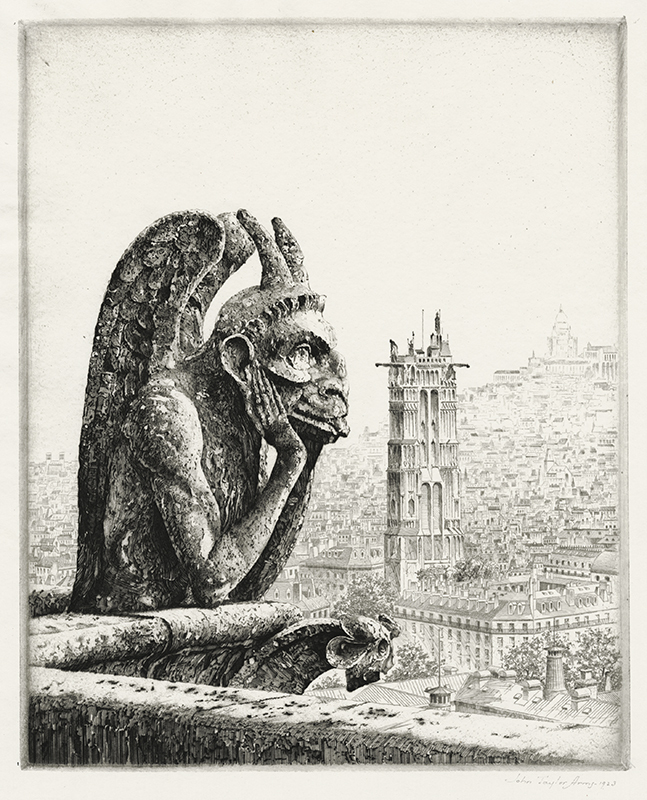
19th, 20th & 21st Century Fine Prints
707-546-7352 · fax 707-546-7924 · web: www.annexgalleries.com · email: artannex@aol.com
Le Penseur de Notre Dame by John Taylor Arms

Le Penseur de Notre Dame
John Taylor Arms
Le Penseur de Notre Dame
John Taylor Arms
1887 - 1953 (biography)Arms was fascinated by what he termed the 'Gothic Spirit' in early Gothic architecture. One of his focuses was on the elaborate waterspouts on the cathedrals, carved in the shapes of "gargoyles". In 1920 he began a series of 41 prints featuring various gargoyles and chimeras of the French cathedrals. It is reported that he would climb out to the facade to a building in order to get what he felt was the best angle for an etching.
Le Penseur de Notre Dame is one of the best-known images in Arms’ gargoyle series. Its actual name is 'Le Stryge' and it is a fabulous 19th century addition to the façade of the Gothic Notre Dame Cathedral. It was created by the architect Eugène Emmanuel Viollet-le-Duc during a major renovation. Le Stryge, also known as The Vampire or The Spitting Gargoyle, is perched on the balustrade of the cathedral’s gallery. Le Stryge is not technically a gargoyle, but is a 'chimera', as it doesn’t function as a downspout, Gargoyles, decorative water spouts employed to drain water from rooftops, were designed in the forms of fanciful animals or figures. John Taylor Arms was also a trained architect who felt very deeply that man’s greatest achievements in architecture are evidenced in the cathedrals and churches from the Gothic era.
In his writings, Arms praised the architects, builders, and stonemasons: The devotion and aspiration that went into their construction is echoed in every line and detail and mass. From the architects who planned them down to the humblest stonecutter who carved the most inconspicuous of their mouldings, we feel a spiritual and imaginative fervor which has no parallel in the history of buildings.
John Taylor Arms, printmaker, lecturer, illustrator, and administrator, was born in Washington, D.C. on 19 April 1887. He first studied law at Princeton University but transferred to the Massachusetts Institute of Technology to study architecture, earning a Master's Degree in 1912. He studied with Ross Turner, David A. Gregg, and Felton Brown. For five years after his graduation Arms worked for the architectural firm Carrere and Hastings, before establishing his own architectural firm of which he was a partner.
A gift of an etching kit from his wife, Dorothy, changed the course of his life. He produced his first etching in 1915 and he eventually produced 441 prints, mostly etchings. Arms became one of the most famous printmakers of the first half of the twentieth century. He is mostly noted for his etchings of medieval architecture but early subjects also included ships, sailboats, airplanes, rural landscapes, and the streets, buildings, and bridges of New York.
Arms' exhibition history was lengthy beginning in 1927 and continuing to 1952. He authored 'Hand-Book of Print Making and Print Makers' in 1934 and illustrated 'Churches of France' and 'Hill Towns and Cities of Northern Italy' by his wife, Dorothy Noyes Arms. His work can be found in most major collections of American prints.
Arms was an activist for printmaking and assisted in assembling exhibitions of American graphic art that were shown in Sweden, Czechoslovakia and Rome; he was editor of the Print Department of Print, A Quarterly Journal of the Graphic Arts, and he lectured on the techniques, history and value of original prints. Arms also served as the president of the Tiffany Foundation in 1940. John Taylor Arms died in New York City on 15 October 1953.


